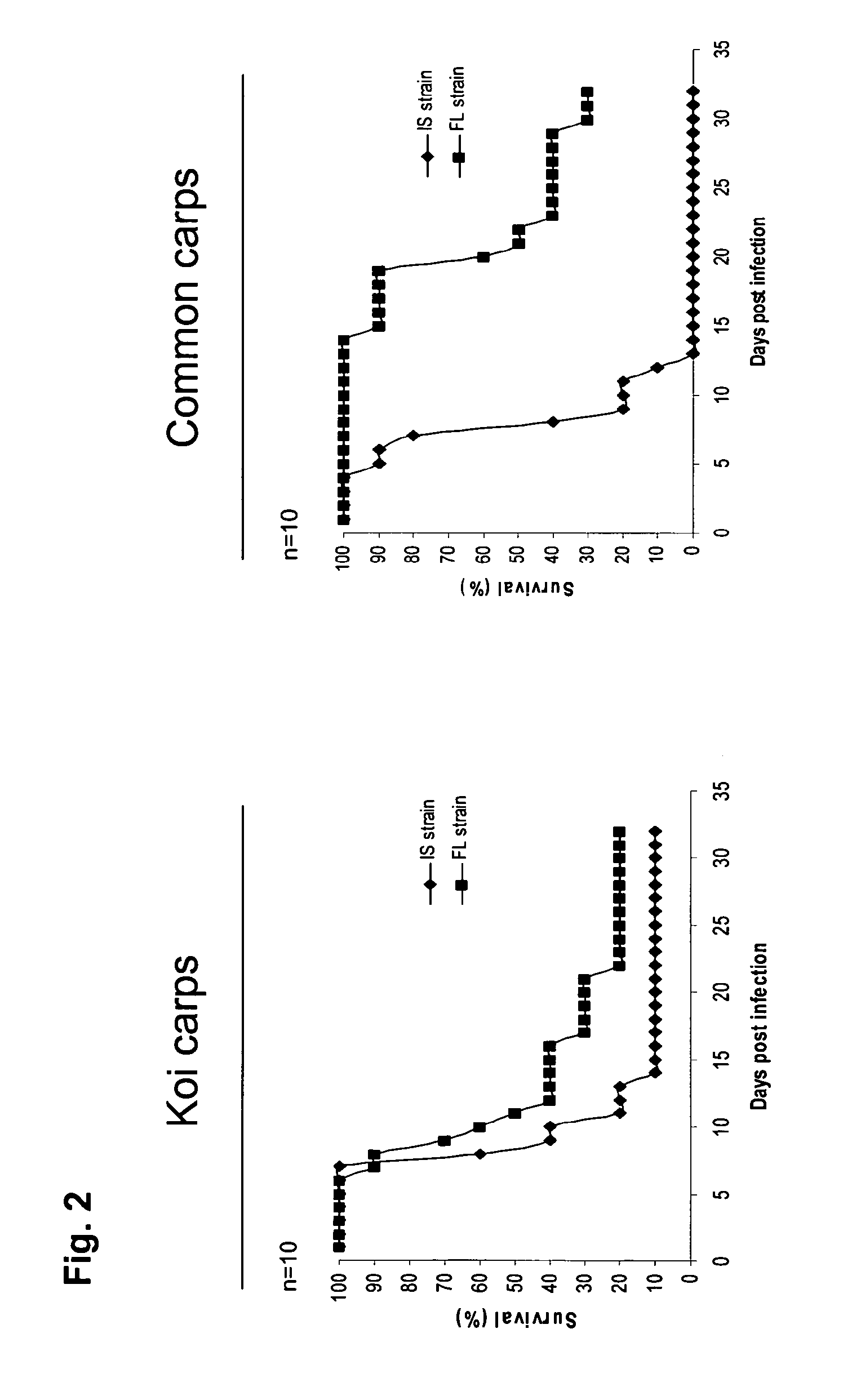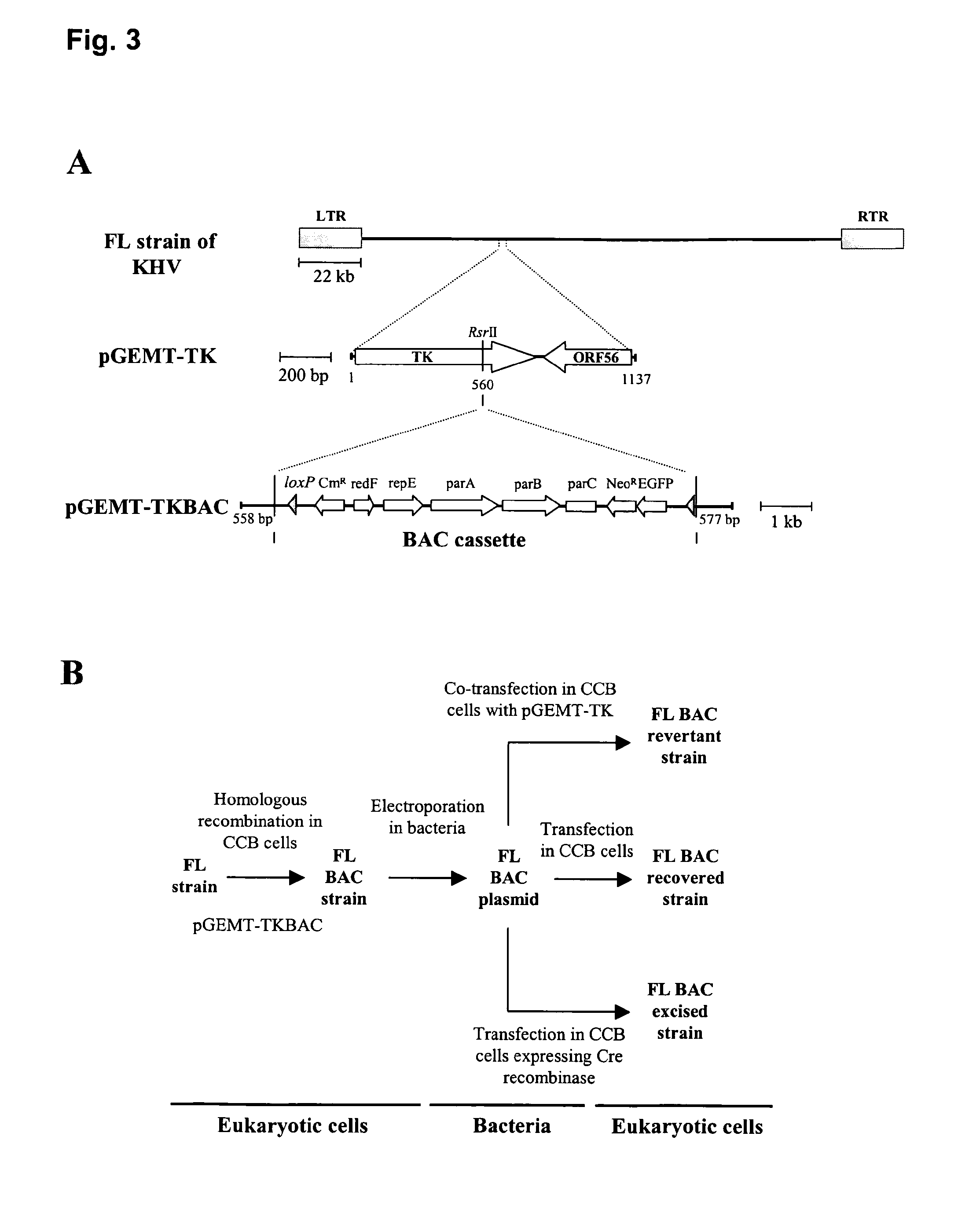Recombinant koi herpesvirus (KHV) or cyprinid herpesvirus 3 (cyhv-3) and a vaccine for the prevention of a disease caused by khv/cyhv-3 in cyprinus carpio carpio or cyprinus carpio koi
- Summary
- Abstract
- Description
- Claims
- Application Information
AI Technical Summary
Benefits of technology
Problems solved by technology
Method used
Image
Examples
example 1
The KHV FL Strain has Intrinsic Properties as a Parental Strain for Production of Derived Attenuated Recombinant Vaccines
[0129]Field strains were tested for their growth properties in vitro and their virulence in vivo. The KHV FL strain was selected at the end of this screening process as parental strain for production of derived attenuated recombinant strains. FIG. 1 illustrates the growth properties of the KHV FL strain as compared to two KHV reference strains (IS and KHV-U strains), the FL strain replicated more efficiently in vitro. FIG. 2 shows that in vivo the KHV FL strain was less pathogenic than the KHV IS strain. Indeed, when assayed on 7 g koi carps, the IS and the FL strain led to 90% and 80% mortality, respectively (FIG. 2). Interestingly, when assayed on 2 g common carps, the onset of the disease induced by the FL strain was delayed by two weeks in comparison to the IS strain. In view of the observed delay by two weeks compared to the higher virulent KHV strain and con...
example 2
Cloning of the KHV Genome in E. coli
[0130]In order to produce KHV recombinant strains, the genome of the KHV FL strain was cloned as a BAC. The approach depicted in FIG. 3 was used to BAC clone KHV. This approach required as a first step the insertion of the BAC cassette into the KHV genome by homologous recombination in eukaryotic cells. As the genome of KHV was only partially sequenced when the present inventors started their study, the insertion site of the BAC cassette was selected at the end of the TK gene (FIG. 3A). Transfection of pGEMT-TKBAC into KHV-infected COB cells generated the KHV FL BAC strain (FIG. 3B). The ability of the latter virus to grow in the presence of G418 allowed its isolation from the parental strain. Moreover, expression of EGFP induced by the KHV FL BAC strain was used to monitor progress of the selection process. After three passages of the virus in the presence of G418, a pure KHV FL BAC population was obtained. The molecular structure of the KHV FL ...
example 3
Stability of the KHV Genome in E. coli
[0131]BAC plasmids are usually propagated in bacteria carrying recA mutation that minimizes recombination. However, the large size and the complex structure of KHV genome could lead to a relative instability of the BAC plasmid (Ilouze et al., Microbiol. Mol. Biol. Rev., 70 (1), 147-156, (2006)). To assess the stability of KHV genome as a BAC plasmid, bacteria containing KHV FL BAC plasmid were serially cultured for 20 consecutive days, each day representing approximately 36 generations. After various periods of culture, the BAC plasmids were isolated and characterized by SacI endonuclease digestion (FIG. 6). No difference was observed among plasmids grown for various periods of time, demonstrating a high stability of the KHV genome in E. coli.
PUM
| Property | Measurement | Unit |
|---|---|---|
| Mortality rate | aaaaa | aaaaa |
| Mortality rate | aaaaa | aaaaa |
| Mortality rate | aaaaa | aaaaa |
Abstract
Description
Claims
Application Information
 Login to View More
Login to View More - R&D
- Intellectual Property
- Life Sciences
- Materials
- Tech Scout
- Unparalleled Data Quality
- Higher Quality Content
- 60% Fewer Hallucinations
Browse by: Latest US Patents, China's latest patents, Technical Efficacy Thesaurus, Application Domain, Technology Topic, Popular Technical Reports.
© 2025 PatSnap. All rights reserved.Legal|Privacy policy|Modern Slavery Act Transparency Statement|Sitemap|About US| Contact US: help@patsnap.com



